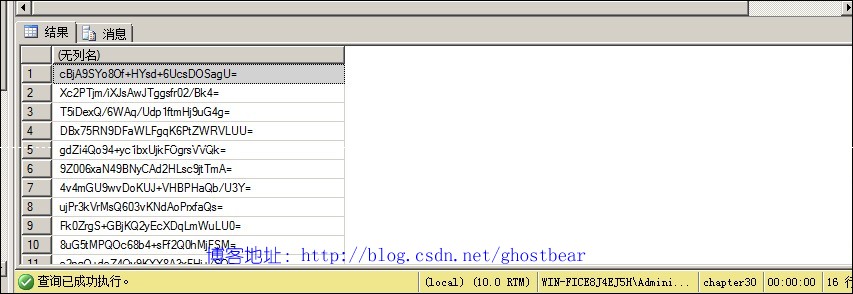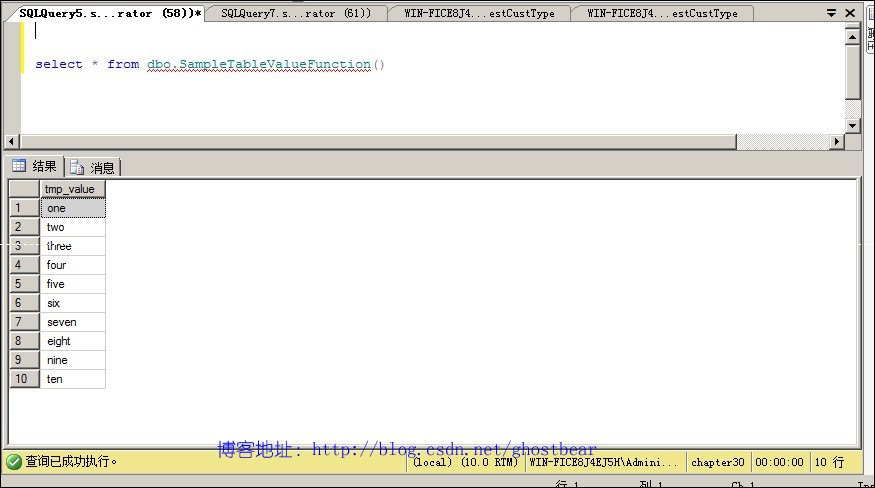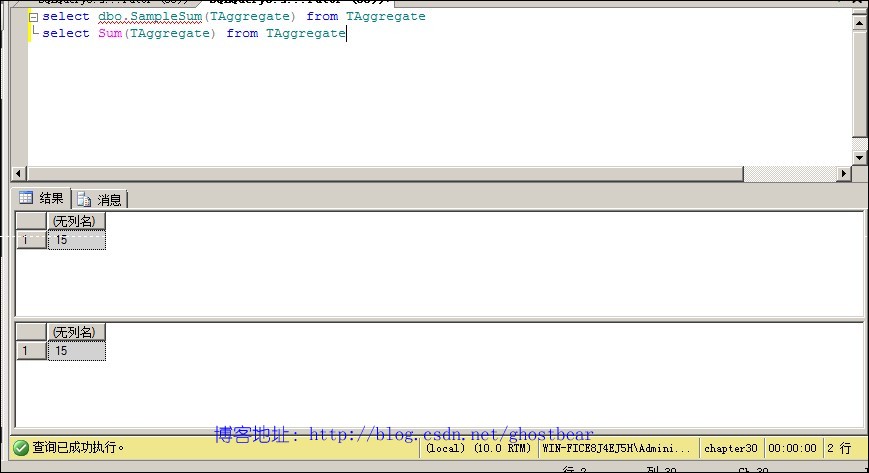你还在为数据库编程而抓狂吗?那些恶心的脚本拼接,低效的脚本调试的日子将会与我们越来越远啦。现在我们能用支持.NET的语言来开发数据库中的对象,如:存储过程,函数,触发器,集合函数已及复杂的类型。看到这些你还能淡定吗?哈哈,不仅仅是这些。那些能被.NET支持的第三方扩展通过该技术统统都能应用在数据库编程上,如:正则表达式,.NET庞大的加密解密库,以及各种.NET集成的排序和搜索算法。
下面我就来一一介绍怎么使用该技术来解放我们的双手!
实现存储过程
using System;
using System.Collections.Generic;
using System.Linq;
using System.Text;
using Microsoft.SqlServer.Server;
using System.Data;
using System.Data.SqlClient;
using System.Data.SqlTypes;
using System.Collections;
public class SampleStoreProcedure
{
[SqlProcedure]
public static void PrintStudentDetail()
{
SqlConnection conn = new SqlConnection("Context connection=true");
conn.Open();
SqlCommand cmd = new SqlCommand("select * from student", conn);
SqlCommand cmd2 = new SqlCommand("insert into studentdetail values(@detail)");
SqlDataReader reader;
string tmpData=string.Empty;
ArrayList tmpDataArray=new ArrayList();
reader = cmd.ExecuteReader();
while (reader.Read())
{
for (int i = 0; i < reader.FieldCount; i++)
{
tmpData += reader[i].ToString();
}
tmpDataArray.Add(tmpData);
}
reader.Close();
cmd2.Connection = conn;
foreach (string tmp in tmpDataArray)
{
cmd2.Parameters.Clear();
cmd2.Parameters.AddWithValue("@detail", tmp);
cmd2.ExecuteNonQuery();
}
conn.Close();
//conn2.Close();
}
[SqlProcedure]
public static void GetStudentDetail(int id)
{
SqlConnection conn = new SqlConnection("Context connection=true");
SqlCommand cmd = new SqlCommand("select * from student where id=@id", conn);
SqlDataReader reader;
cmd.Parameters.AddWithValue("@id", id);
try
{
conn.Open();
reader = cmd.ExecuteReader();
SqlPipe pipe = SqlContext.Pipe;
pipe.Send(reader);
reader.Close();
}
catch
{
conn.Close();
}
finally
{
}
}
};
部署步骤
1.编译项目,获取生成的DLL文件。
2.在数据库中输入命令sp_configure [clr enabled],1 reconfigure --开启对程序集的信任权限。
3.输入命令:create assembly chapter34_UDT from 'c:\chapter34_UDT.dll' 注册程序集
4.输入命令:
--注册存储过程
create procedure PrintStudentDetail
as
external name chapter34_UDT.SampleStoreProcedure.PrintStudentDetail
--注册带参数的存储过程
create procedure GetStudentDetail
(
@Id int
)
as
external name chapter34_UDT.SampleStoreProcedure.GetStudentDetail
执行结果
exec PrintStudentDetail
exec GetStudentDetail 1
存储过程PrintStudentDetail执行结果

存储过程GetStudentDetail执行的结果
实现函数
using System;
using System.Collections.Generic;
using System.Linq;
using System.Text;
using System.Data;
using System.Data.SqlClient;
using System.Data.SqlTypes;
using Microsoft.SqlServer.Server;
using System.Security;
using System.Security.Cryptography;
public class SampleFunction
{
public SampleFunction()
{
}
[SqlFunction]
public static SqlString Hash(SqlString data)
{
SHA1 sha1 = SHA1.Create();
byte[] tmp = Encoding.ASCII.GetBytes(data.Value);
string result= Convert.ToBase64String(sha1.ComputeHash(tmp));
return new SqlString(result);
}
}
部署步骤
1.编译项目,获取生成的DLL文件。
2.在数据库中输入命令:
sp_configure [clr enabled],1 reconfigure --开启对程序集的信任权限。
3.输入命令:
create assembly chapter34_UDT from 'c:\chapter34_UDT.dll' 注册程序集
--如果上述步骤已经做了就忽略
4.输入命令:
--注册函数
create function HashSomeThing(@data nvarchar) returns nvarchar
as
external name chapter34_UDT.SampleFunction.[Hash]
执行结果
输入调用命令:
select dbo.HashSomeThing(name) from Student
实现表值函数
using System;
using System.Collections.Generic;
using System.Linq;
using System.Text;
using System.Data;
using System.Data.SqlClient;
using System.Data.SqlTypes;
using Microsoft.SqlServer.Server;
using System.Text.RegularExpressions;
using System.Xml.Linq;
using System.Xml;
using System.IO;
using System.Collections;
public class SampleTableValueFunction
{
///
/// 表值函数的主体,该函数需要结合“内容填充函数”才能发挥功能。这里的“内容填充函数”是通过
/// 属性“FillRowMethodName”属性来指定的。属性“TableDefinition”用来定义返回表格的格式。
///
[SqlFunction(TableDefinition = "tmp_value nvarchar(max)", FillRowMethodName = "FillRow")]
public static IEnumerable PrintOneToTen()
{
IList<string> result2 = new List<string>();
var matches = new string[]{
"one",
"two",
"three",
"four",
"five",
"six",
"seven",
"eight",
"nine",
"ten"
};
return matches.AsEnumerable();
}
public static void FillRow(object obj, out SqlString tmp)
{
tmp = new SqlString(obj.ToString());
}
}
部署步骤
1.编译项目,获取生成的DLL文件。
2.在数据库中输入命令:
sp_configure [clr enabled],1 reconfigure --开启对程序集的信任权限。
3.输入命令:
create assembly chapter34_UDT from 'c:\chapter34_UDT.dll' 注册程序集
--如果上述步骤已经做了就忽略
4.输入命令:
create function SampleTableValueFunction() returns table(tmp_value nvarchar(max) null)
as
external name chapter34_UDT.SampleTableValueFunction.PrintOneToTen
执行结果

实现触发器
using System;
using System.Collections.Generic;
using System.Linq;
using System.Text;
using Microsoft.SqlServer.Server;
using System.Data;
using System.Data.SqlClient;
using System.Data.SqlTypes;
public class SampleTrigger
{
public SampleTrigger()
{
}
[SqlTrigger(Event = "For Insert,Update,Delete", Name = "PrintInfo", Target = "Student")]
public static void PrintInfo()
{
SqlTriggerContext triggerContext = SqlContext.TriggerContext;
SqlConnection conn = new SqlConnection("Context connection=true");
SqlCommand cmd = new SqlCommand();
cmd.Connection = conn;
switch (triggerContext.TriggerAction)
{
case TriggerAction.Insert:
cmd.CommandText = "insert into StudentDetail values('insert operation!')";
break;
case TriggerAction.Delete:
cmd.CommandText = "insert into StudentDetail values('delete operation!')";
break;
case TriggerAction.Update:
cmd.CommandText = "insert into StudentDetail values('update operation!')";
break;
default:
break;
}
try
{
conn.Open();
cmd.ExecuteNonQuery();
}
catch
{
}
finally
{
conn.Close();
}
}
[SqlTrigger(Name="InsertSomething",Target="chapter30.dbo.Student",Event="FOR INSERT")]
public static void InsertSomething()
{
SqlTriggerContext triggerContext = SqlContext.TriggerContext;
if (triggerContext.TriggerAction == TriggerAction.Insert)
{
var conn = new SqlConnection("Context connection=true");
var cmd = new SqlCommand();
cmd.Connection = conn;
cmd.CommandText = "Insert into StudentDetail values('insert event')";
conn.Open();
cmd.ExecuteNonQuery();
conn.Close();
}
}
}
部署步骤
1.编译项目,获取生成的DLL文件。
2.在数据库中输入命令:
sp_configure [clr enabled],1 reconfigure --开启对程序集的信任权限。
3.输入命令:
create assembly chapter34_UDT from 'c:\chapter34_UDT.dll' 注册程序集
--如果上述步骤已经做了就忽略
4.输入命令:
--注册触发器
create trigger PrintSomething on Student
for insert,update,delete
as
external name chapter34_UDT.SampleTrigger.PrintInfo
执行结果
输入命令:
insert into Student values(12345,'tmp','11','11')
update Student set Name='new'+Name where Id=12345
delete from Student where Id=12345
select * from StudentDetail
实现聚合函数
using System;
using System.Collections.Generic;
using System.Linq;
using System.Text;
using Microsoft.SqlServer.Server;
using System.Data;
using System.Data.SqlClient;
using System.Data.SqlTypes;
[Serializable]
[SqlUserDefinedAggregate(Format.Native)]
public struct SampleSum
{
private int sum;
public void Init()
{
sum = 0;
}
public void Accumulate(SqlInt32 Value)
{
sum += Value.Value;
}
public void Merge(SampleSum Group)
{
sum += Group.sum;
}
public SqlInt32 Terminate()
{
return new SqlInt32(sum);
}
}
部署步骤
1.编译项目,获取生成的DLL文件。
2.在数据库中输入命令:
sp_configure [clr enabled],1 reconfigure --开启对程序集的信任权限。
3.输入命令:
create assembly chapter34_UDT from 'c:\chapter34_UDT.dll' 注册程序集
--如果上述步骤已经做了就忽略
4.输入命令:
--注册聚合函数
create aggregate SampleSum(@value int) returns int
external name [chapter34_UDT].SampleSum
执行结果
输入命令:
select dbo.SampleSum(TAggregate) from TAggregate
select Sum(TAggregate) from TAggregate

实现类型
using System;
using System.Collections.Generic;
using System.Linq;
using System.Text;
using Microsoft.SqlServer.Server;
using System.Data.SqlTypes;
using System.Data;
using System.Data.SqlClient;
[Serializable]
[Microsoft.SqlServer.Server.SqlUserDefinedType(Format.Native)]
public struct Facade : INullable
{
public bool isNull;
int hairColor;
int tall;
int skin;
int country;
public Facade(int hairColor, int tall, int skin, int country)
{
isNull = false;
this.hairColor = hairColor;
this.tall = tall;
this.skin = skin;
this.country = country;
}
public static Facade Null
{
get
{
return new Facade { isNull = true };
}
}
public override string ToString()
{
StringBuilder sb = new StringBuilder();
sb.AppendFormat("{0};", hairColor);
sb.AppendFormat("{0};", tall);
sb.AppendFormat("{0};", skin);
sb.AppendFormat("{0}", country);
return sb.ToString();
}
public static Facade Parse(SqlString data)
{
if (data.IsNull)
{
return new Facade { isNull = true };
}
Facade result;
string[] tmpData = data.Value.Split(';');
result = new Facade(int.Parse(tmpData[0]), int.Parse(tmpData[1]), int.Parse(tmpData[2]), int.Parse(tmpData[3]));
return result;
}
public bool IsNull
{
get { return isNull; }
}
}
部署步骤
1.编译项目,获取生成的DLL文件。
2.在数据库中输入命令:
sp_configure [clr enabled],1 reconfigure --开启对程序集的信任权限。
3.输入命令:
create assembly chapter34_UDT from 'c:\chapter34_UDT.dll' 注册程序集
--如果上述步骤已经做了就忽略
4.输入命令:
create type Facade external name
[chapter34_UDT].Facade
执行结果

小结
CLR Sql Server 的推出大大的提高了Sql Server的脚本编程效率问题,并且这项技术给了我们很大的相信空间。现在我们就来用有限的手段实现无限的可能吧!
代码下载























 2646
2646

 被折叠的 条评论
为什么被折叠?
被折叠的 条评论
为什么被折叠?








